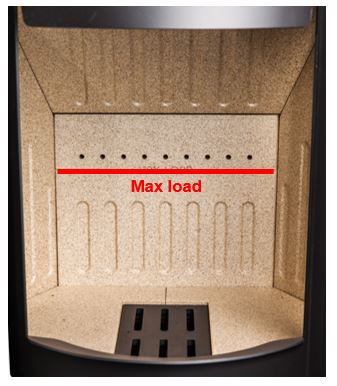Ticking or banging noises are a common characteristic of metal stoves and are generally due to the metal expanding in the heat generated by the combustion and as such can also be a useful indicator of the intensity of the combustion. Many people experience this ‘ticking’ or ‘clicking’ as part of the comfort of having a stove. The tensions will decrease over time and can be minimised by firing up the stove a few times.
Ticking noises are a common characteristic of stoves made of sheet iron and are caused by the expansion of the iron as it heats up. The sounds are most common during ignition and firing, as well as during cooling. If the sounds become very frequent once the stove has warmed up, it may be a sign that the stove is overheating or needs some minor adjustments. New stoves tend to make a lot of noise during the first few fires until the metal has set. The noise will diminish over time and can be minimised by firing up the stove a few times.
Make sure the stove is not overheating
- Make sure the Aduro-tronic is used according to the procedure in the manual. The damper should stay in the initial (closed) position except during firing up or reloading. Only use the Aduro Key to keep the damper open when lighting up the stove.
- Check that your installation is done according to the instructions in the manual. The ideal draft is around 12 Pa. If the draft is too high, it is often possible to hear wind howling coming from the stove. The draft can be reduced by installing a pipe damper or a different chimney cowl.
Do not overload
Consult the manual of the stove to check the maximum quantity of wood. In most Aduro stoves, there is an indication of maximum load. Use this indication as a reference when loading the stove. Always load the stove below the max load indication.

Use the correct kind of wood
The stove is designed to operate with firewood with a moisture between 10% and 18%. If the wood is too dry and in small pieces, it might produce too much heat.
Use the correct combustible
Make sure to burn only seasoned firewood that is designed for the use in wood burning stoves. Pellet, wood shavings or other alternative products are not ideal for use.
Use the correct size of wood
Use a mix of small and big logs. If the stove is loaded with too many small pieces, it will overheat.
To reduce the noise it is possible to try the following adjustments. Please note that not all stoves are fitted with removable back/baffle plate. Most of them have at least one of the two options.
WARNING: Proceed the following only with a cold stove!
Loosen the back plate slightly
The back plate is often the largest single metal sheet in the stove and as such, can make some noises when exposed to heat. To decrease the tension in the metal do as follows:
- Locate the back-plate screws on your stove. Most stoves are fitted with a removable back plate, hold in position by screws. Screws are usually on the top and bottom part of the back plate.
- Untie the screws. Make sure that the back plate is still attached firmly to the stove, but at the same time has some extra tolerance to allow extra expansion.
Loosen the metal baffle plate slightly
The metal baffle plate is directly exposed to a very high heat and as a result can expand beyond the normal tolerances. For some Aduro stoves, the metal baffle plate is attached to the stove with bolts. To decrease the tension in the metal, please proceed as follows:
- Locate the metal baffle plate in the stove. To access the metal baffle plate, gently remove the top vermiculite plate from the combustion chamber.
- Untie the bolts. Make sure that the metal baffle plate is still attached firmly to the stove, but at the same time has some extra tolerance to allow extra expansion.
Picture 1: Baffle plate in vermiculite
Picture 2: Bolts in the metal baffle plate
Perform a full power combustion
Often stoves emit the ticking noise when the metal has not yet been exposed to enough heat to expand and settle into its final shape.
It is possible to trigger this process by heating up the stove considerably for a limited amount of time as follows:
- Load the stove with a full load (check the manual for the maximum quantity)
- Light up the fire and use the Aduro Key to force open the primary air intake for the whole duration of the fire. This will add extra oxygen into the combustion, rising the temperature.
As the very intense heat generated by this process puts a strain on the stove’s structure it is advisable to limit, if not avoid, full power combustions unless necessary. One or two full power combustions are usually enough for the metal to expand into its final shape.


